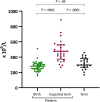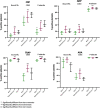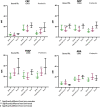Reduced platelet function in preterm neonates compared with term neonates
- PMID: 35928524
- PMCID: PMC9343599
- DOI: 10.1002/rth2.12751
Reduced platelet function in preterm neonates compared with term neonates
Abstract
Background: A reduced platelet function might contribute to the longer bleeding time seen in preterm neonates. However, the previously used platelet function testing in neonates is limited due to methodological limitations, mainly caused by difficulties in obtaining adequate blood volume. Therefore, the platelet function in preterm neonates is sparsely investigated. The aim of this study was to compare platelet function in preterm neonates at birth and at expected term age with platelet function in term neonates at birth.
Methods: We included 43 preterm neonates born at gestational age (GA) 28 + 0 to 34 + 0 and 21 term neonates born at GA 38 + 0 to 41 + 0. Within the first 24 hours of life, 1-1.5 mL peripheral blood was obtained and for preterm neonates, resampling was performed at expected term age (GA 38 + 0 to 41 + 0). Platelet function testing included impedance aggregometry and platelet activation measured by flow cytometry. In addition, platelet count was determined.
Results: Platelet count and platelet activation were reduced in preterm neonates compared with term neonates at birth, but we found no difference in impedance aggregometry at birth. At expected term age, platelet count and aggregation exceeded term levels, but platelet activation remained impaired in the preterm.
Conclusion: Preterm neonatal function is decreased at birth and does not seem to reach term levels during the first 4 to 13 weeks of life.
Keywords: flow cytometry; infant, premature; platelet activation; platelet count; platelet function tests.
© 2022 The Authors. Research and Practice in Thrombosis and Haemostasis published by Wiley Periodicals LLC on behalf of International Society on Thrombosis and Haemostasis (ISTH).
Figures





Similar articles
-
Sepsis-induced coagulopathy in preterm neonates with Gram-positive sepsis presents with hypercoagulation and reduced platelet activation compared with healthy preterm neonates.Res Pract Thromb Haemost. 2023 Mar 7;7(2):100100. doi: 10.1016/j.rpth.2023.100100. eCollection 2023 Feb. Res Pract Thromb Haemost. 2023. PMID: 37063768 Free PMC article.
-
Dynamic platelet function on von Willebrand factor is different in preterm neonates and full-term neonates: changes in neonatal platelet function.J Thromb Haemost. 2016 Oct;14(10):2027-2035. doi: 10.1111/jth.13414. Epub 2016 Aug 20. J Thromb Haemost. 2016. PMID: 27416003
-
Template bleeding times of 240 neonates born at 24 to 41 weeks gestation.J Perinatol. 2008 Jun;28(6):427-31. doi: 10.1038/jp.2008.10. Epub 2008 Feb 14. J Perinatol. 2008. PMID: 18273029
-
Platelet function testing in pediatric patients.Expert Rev Hematol. 2017 Apr;10(4):281-288. doi: 10.1080/17474086.2017.1293518. Epub 2017 Mar 2. Expert Rev Hematol. 2017. PMID: 28347215 Review.
-
Platelet function in term and preterm neonates.Clin Perinatol. 2004 Mar;31(1):15-28. doi: 10.1016/j.clp.2004.03.009. Clin Perinatol. 2004. PMID: 15183653 Review.
Cited by
-
Ontogenesis of functional platelet subpopulations from preterm and term neonates to adulthood: The PLINIUS study.Blood Adv. 2023 Aug 22;7(16):4334-4348. doi: 10.1182/bloodadvances.2023009824. Blood Adv. 2023. PMID: 37042931 Free PMC article.
-
Sepsis-induced coagulopathy in preterm neonates with Gram-positive sepsis presents with hypercoagulation and reduced platelet activation compared with healthy preterm neonates.Res Pract Thromb Haemost. 2023 Mar 7;7(2):100100. doi: 10.1016/j.rpth.2023.100100. eCollection 2023 Feb. Res Pract Thromb Haemost. 2023. PMID: 37063768 Free PMC article.
References
-
- Harrison MS, Goldenberg RL. Global burden of prematurity. Semin Fetal Neonatal Med. 2016;21(2):74‐79. - PubMed
-
- Horbar JD, Carpenter JH, Badger GJ, et al. Mortality and neonatal morbidity among infants 501 to 1500 grams from 2000 to 2009. Pediatrics. 2012;129(6):1019‐1026. - PubMed
-
- Fanaroff AA, Stoll BJ, Wright LL, et al. Trends in neonatal morbidity and mortality for very low birthweight infants. Am J Obstet Gynecol. 2007;196(2):147.e1‐e8. - PubMed
-
- Ward RM, Beachy JC. Neonatal complications following preterm birth. BJOG. 2003;110(s20):8‐16. - PubMed
LinkOut - more resources
Full Text Sources

